So I discovered a trick last night – if I run my finger over a clownfish nest, the fish inside the eggs will wiggle if alive. So despite having had no appreciable hatch all day, I pulled the tile, sanitized it again with H2O2, and threw it back in the larval tank. I DID get a few eggs to hatch during the vigorous aeration in the sanitizing dip, so that further told me I was on the right path.
I didn’t get to check the nest until 4 PM today, but sure enough, there were significantly more larvae in the tank. It required a new strong feeding with rotifers. I once again tested the eggs…still viable, so I put some ChloramX in the water, and left the tile back in there. They may not get checked again until tomorrow…
- About The Lightning Project
- Inventory of F1 PNG Lightning and White Stripe Maroon Clownfish
- F1 PNG Lightning Maroon Clownfish, BZLM1
- F1 PNG Lightning Maroon Clownfish, BZLM2
- F1 PNG Lightning Maroon Clownfish, FW1
- F1 PNG Lightning Maroon Clownfish, LM10
- F1 PNG Lightning Maroon Clownfish, LM11
- F1 PNG Lightning Maroon Clownfish, LM12
- F1 PNG Lightning Maroon Clownfish, LM13
- F1 PNG Lightning Maroon Clownfish, LM14
- F1 PNG Lightning Maroon Clownfish, LM15
- F1 PNG Lightning Maroon Clownfish, LM16
- F1 PNG Lightning Maroon Clownfish, LM17
- F1 PNG Lightning Maroon Clownfish, LM18
- F1 PNG Lightning Maroon Clownfish, LM19
- F1 PNG Lightning Maroon Clownfish, LM20
- F1 PNG Lightning Maroon Clownfish, LM3
- F1 PNG Lightning Maroon Clownfish, LM4
- F1 PNG Lightning Maroon Clownfish, LM5
- F1 PNG Lightning Maroon Clownfish, LM6
- F1 PNG Lightning Maroon Clownfish, LM7
- F1 PNG Lightning Maroon Clownfish, LM8
- F1 PNG Lightning Maroon Clownfish, LM9
- F1 PNG Lightning Maroon Clownfish, MD1
- F1 PNG Lightning Maroon Clownfish, MWP3
- F1 PNG Lightning Maroon Clownfish, WS17
- F1 PNG Lightning Maroon, EC1
- F1 PNG Lightning Maroon, GL1
- F1 PNG White Stripe Maroon Clownfish, BZWS1
- F1 PNG White Stripe Maroon Clownfish, BZWS2
- F1 PNG White Stripe Maroon Clownfish, BZWS3
- F1 PNG White Stripe Maroon Clownfish, WS10
- F1 PNG White Stripe Maroon Clownfish, WS11
- F1 PNG White Stripe Maroon Clownfish, WS12
- F1 PNG White Stripe Maroon Clownfish, WS13
- F1 PNG White Stripe Maroon Clownfish, WS14
- F1 PNG White Stripe Maroon Clownfish, WS15
- F1 PNG White Stripe Maroon Clownfish, WS16
- F1 PNG White Stripe Maroon Clownfish, WS4
- F1 PNG White Stripe Maroon Clownfish, WS5
- F1 PNG White Stripe Maroon Clownfish, WS6
- F1 PNG White Stripe Maroon Clownfish, WS7
- F1 PNG White Stripe Maroon Clownfish, WS8
- F1 PNG White Stripe Maroon Clownfish, WS9
- F1 PNG White Stripe Maroon, EC2
- F1 PNG White Stripe Maroon, FW2
- F1 PNG White Stripe Maroon, GL2
- F1 PNG White Stripe Maroon, MD2
- Lightning Breeding Directive
- Lightning Maroon Clownfish Links
- Home
- About The Lightning Project
- Inventory of F1 PNG Lightning and White Stripe Maroon Clownfish
- F1 PNG Lightning Maroon Clownfish, BZLM1
- F1 PNG Lightning Maroon Clownfish, BZLM2
- F1 PNG Lightning Maroon Clownfish, FW1
- F1 PNG Lightning Maroon Clownfish, LM10
- F1 PNG Lightning Maroon Clownfish, LM11
- F1 PNG Lightning Maroon Clownfish, LM12
- F1 PNG Lightning Maroon Clownfish, LM13
- F1 PNG Lightning Maroon Clownfish, LM14
- F1 PNG Lightning Maroon Clownfish, LM15
- F1 PNG Lightning Maroon Clownfish, LM16
- F1 PNG Lightning Maroon Clownfish, LM17
- F1 PNG Lightning Maroon Clownfish, LM18
- F1 PNG Lightning Maroon Clownfish, LM19
- F1 PNG Lightning Maroon Clownfish, LM20
- F1 PNG Lightning Maroon Clownfish, LM3
- F1 PNG Lightning Maroon Clownfish, LM4
- F1 PNG Lightning Maroon Clownfish, LM5
- F1 PNG Lightning Maroon Clownfish, LM6
- F1 PNG Lightning Maroon Clownfish, LM7
- F1 PNG Lightning Maroon Clownfish, LM8
- F1 PNG Lightning Maroon Clownfish, LM9
- F1 PNG Lightning Maroon Clownfish, MD1
- F1 PNG Lightning Maroon Clownfish, MWP3
- F1 PNG Lightning Maroon Clownfish, WS17
- F1 PNG Lightning Maroon, EC1
- F1 PNG Lightning Maroon, GL1
- F1 PNG White Stripe Maroon Clownfish, BZWS1
- F1 PNG White Stripe Maroon Clownfish, BZWS2
- F1 PNG White Stripe Maroon Clownfish, BZWS3
- F1 PNG White Stripe Maroon Clownfish, WS10
- F1 PNG White Stripe Maroon Clownfish, WS11
- F1 PNG White Stripe Maroon Clownfish, WS12
- F1 PNG White Stripe Maroon Clownfish, WS13
- F1 PNG White Stripe Maroon Clownfish, WS14
- F1 PNG White Stripe Maroon Clownfish, WS15
- F1 PNG White Stripe Maroon Clownfish, WS16
- F1 PNG White Stripe Maroon Clownfish, WS4
- F1 PNG White Stripe Maroon Clownfish, WS5
- F1 PNG White Stripe Maroon Clownfish, WS6
- F1 PNG White Stripe Maroon Clownfish, WS7
- F1 PNG White Stripe Maroon Clownfish, WS8
- F1 PNG White Stripe Maroon Clownfish, WS9
- F1 PNG White Stripe Maroon, EC2
- F1 PNG White Stripe Maroon, FW2
- F1 PNG White Stripe Maroon, GL2
- F1 PNG White Stripe Maroon, MD2
- Lightning Breeding Directive
- Lightning Maroon Clownfish Links
I probably don’t keep as meticulous of records as I should, but the blog here allows me to keep decent notes, rather easily and quickly. From that, it’s possible to reconstruct what’s happened over the past 2 years in terms of spawns and their results, leaving perhaps a few gaps or uncertainties. Here’s a recap, to the best of my records and recollection.
Spawn #34 – small hatch
Spawn #33 – now settled, probably 50-100 fish so long as I don’t screw it up.
Spawn #32 – all died
Spawn #31 – failed collection
spawn #30 = 10 or so alive, all in BRT, looking good
spawn #29 – failed hatch
spawn #28 – mostly failed hatch, all dead
spawn #27 = all at Mike’s – many alive (50+) and looking great
spawn #26 = all dead
spawn #25 = hatch failure?
spawn #24 = hatch failure
spawn #23 = not pulled
spawn #22 = all dead
spawn #21 = was 5 (3L 2WS), the 3L disappeared, found one in the sump, of the two remaining white stripes; perc killed them down to 1, and the survivor is in really rough shape as of today.
spawn #20 = no survivors
spawn #19 = no survivors
spawn #18 = no survivors
spawn #17 = no survirors
spawn #16 = no survirors
spawn #15 = By Nov 28th only 2 alive – I never did account for them, but I presume these were a couple that randomly “went missing” (it seems that many fish wind up going down a certain screened drain pipe)
spawn #14 = 2 lightnings and 1 White Stripe – I remember culling a batch quite heavily, and I’m assuming what is still here (LM19, LM20, WS17) are from that batch.; 10-24-13
spawn #13 = I have it noted as , hatched 9-30 (this might also be LM18, but it seems too small to have made it in with LM17 by the time I first documented it)
spawn #12 = no survivors
Spawn #11 = failed
Spawn #10 = ? (8-16-2013) – 1 survivor went in with fire clowns, LM18; based on other timelines, this is most likely where LM18 came from, because he was younger than LM19 and LM20
Spawn #9 = failed
spawn #8 = vanished (failed)
spawn #7 – failed hatch
spawn #6 = missed hatch
spawn #4 = (4-5-2014) – LM17 came from this clutch.
spawn #3 = no dice.
spawn #2 = where all the 2012 crop came from
Spawn #1 = they ate it…
As of 11 AM, it’s a small hatch on Spawn #34. I added a little RotiGreen Omega to help keep the fish off the walls, and will check a bit later to see if the hatch has improved during the day.
It’s taken over 24 hours of work, but the website has been updated with new photos of many Lightning and White Stripe Maroon Clownfish. 5 new fish have been added to the inventory as well! I’m not going to post every last new photo in a blog post. Instead, you can follow the links to any particular page you’re interested in.
First, we have a great update on Mike Doty’s pair, MD1 and MD2 – I took the photos back in February but only now have them online! Looking at both these fish you can see how they’ve developed over time.
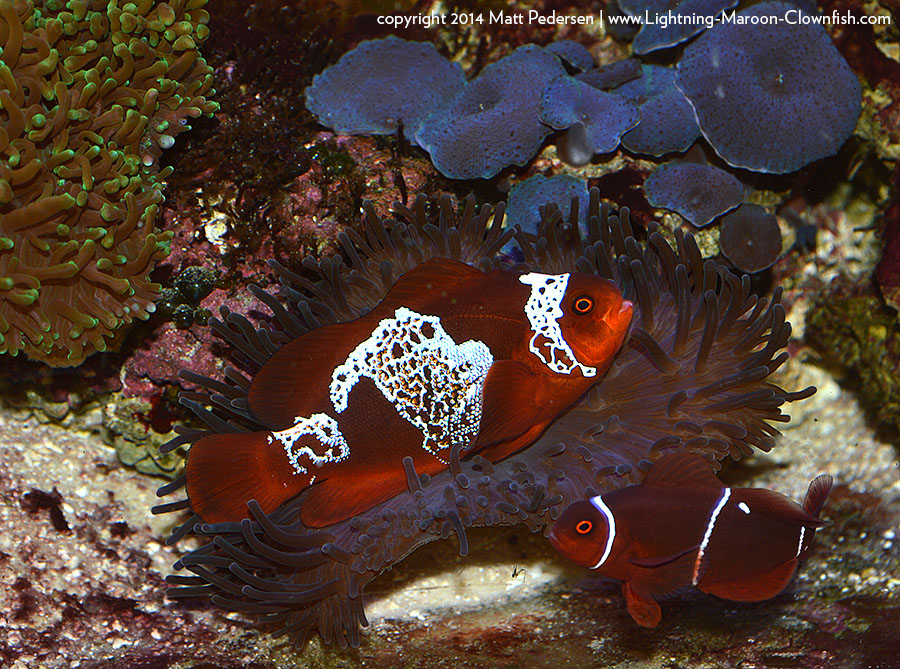
MD1 (Lightning) and MD2 (White Stripe aka. Morse Code) – Feb 28, 2014
MWP3 was added to the inventory – he is a fish I’ve held back due to an obvious dorsal fin defect and had intended to use as the Lightning in a Lightning X White Stripe sibling pairing. At the moment, with no real place to house such a pairing, I may let him go to a new home.
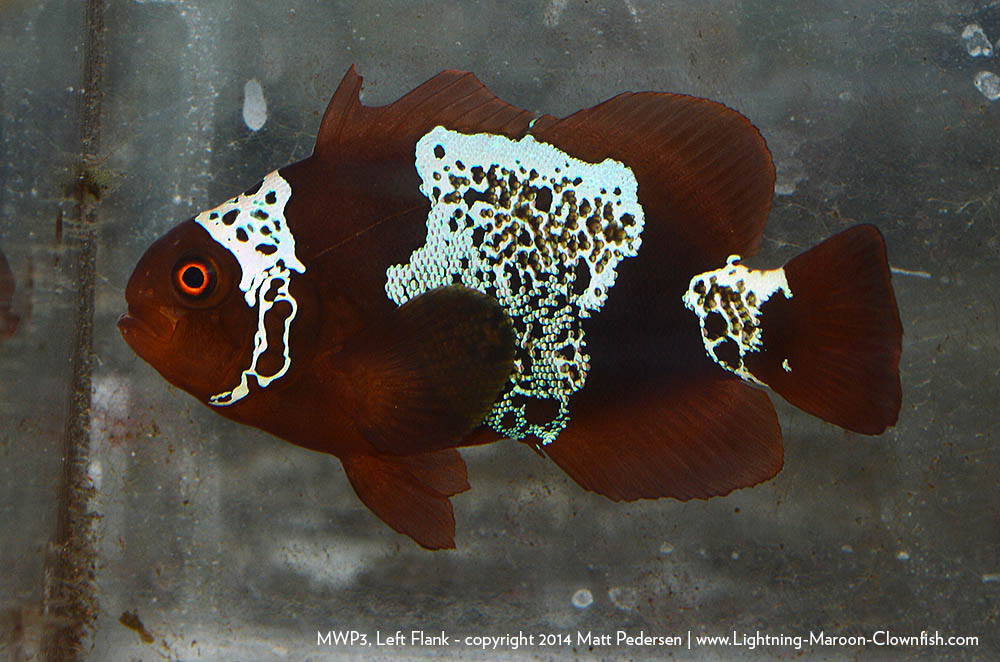
WS4, WS11 and WS13 are all White Stripe Maroons that have been here for 2 years now; I wasn’t able to get any good new photos of WS13, but WS4 and WS11 have updates, and all three fish have now been measured too!
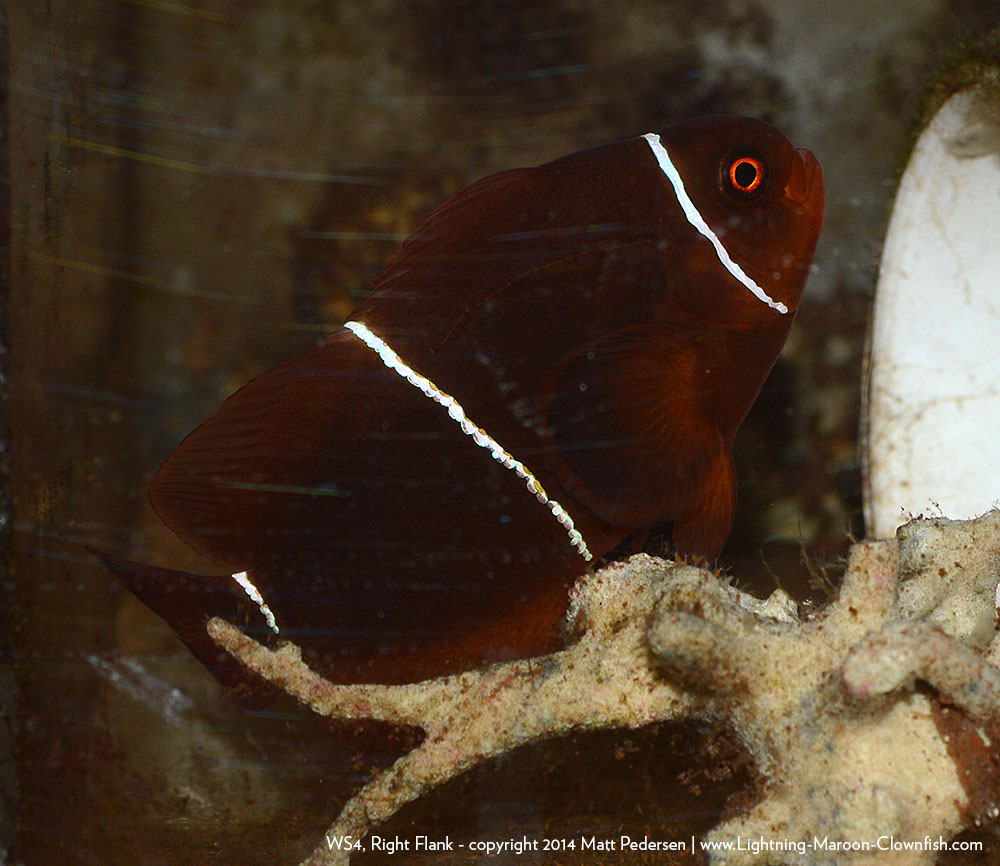
The same can be said for LM9, LM11, LM14.
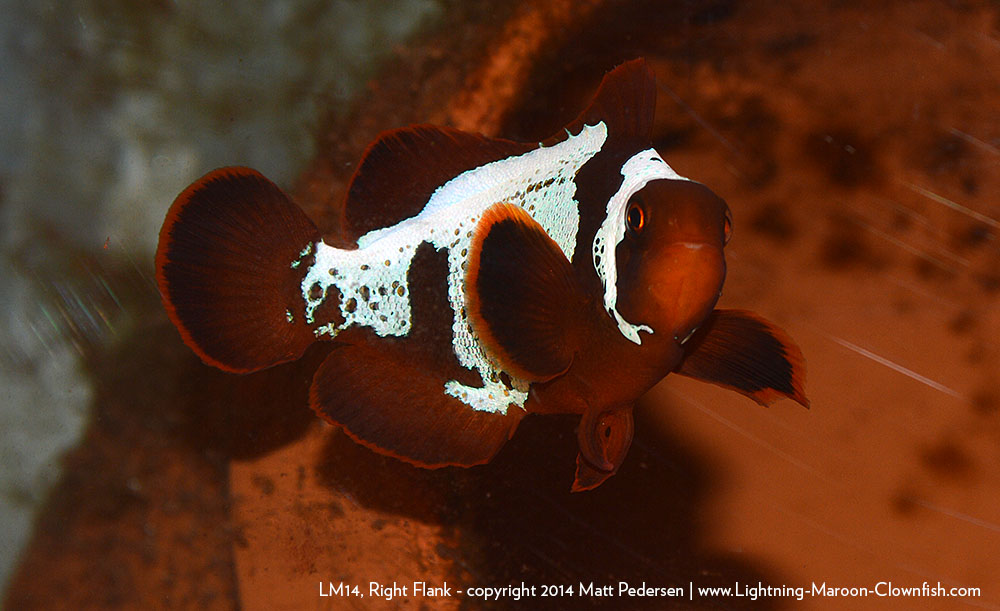
LM17 and LM18 remain together, and LM18 has finally been given its own page.
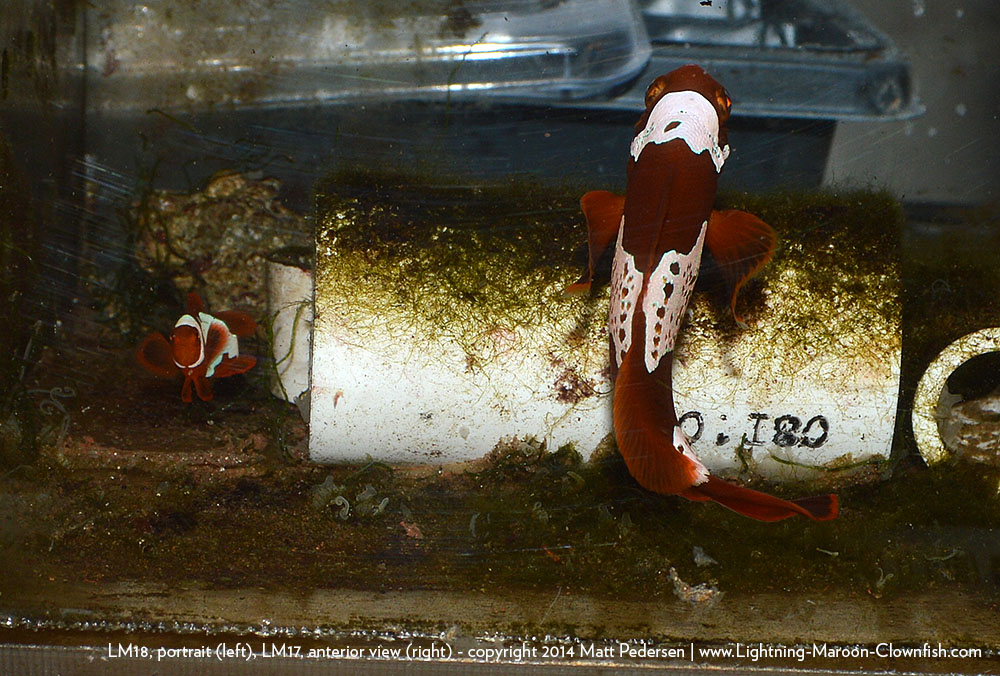
And finally, your first look at 3 new offspring – WS17, LM19 and LM20! All three of these were reared in individual containers from a very young age, and it seems that has really helped produced better offspring (no battle scars from being reared together)!
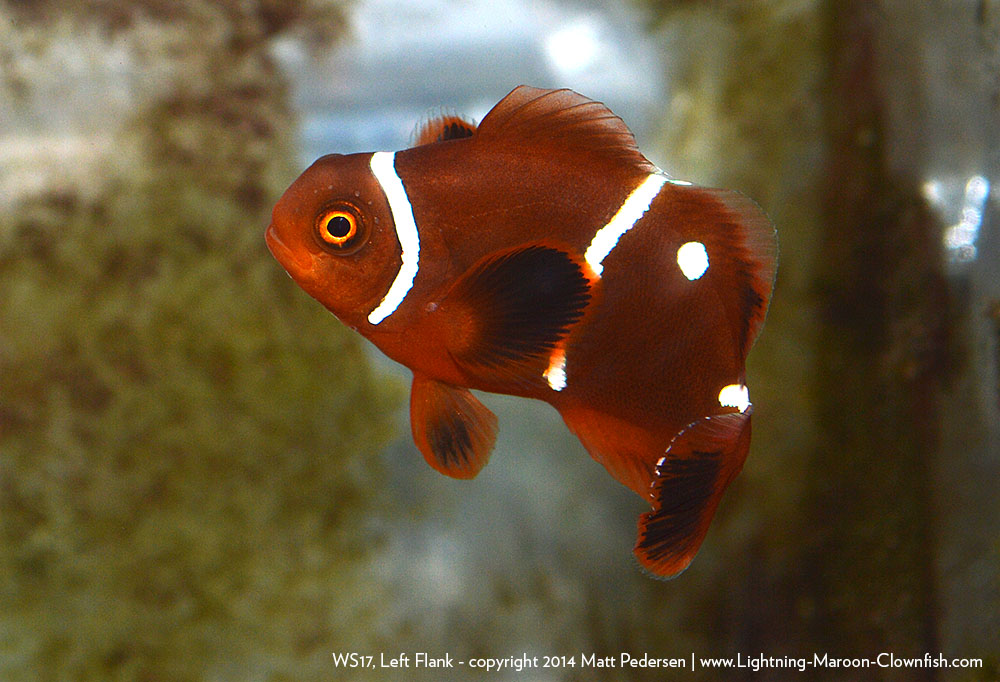
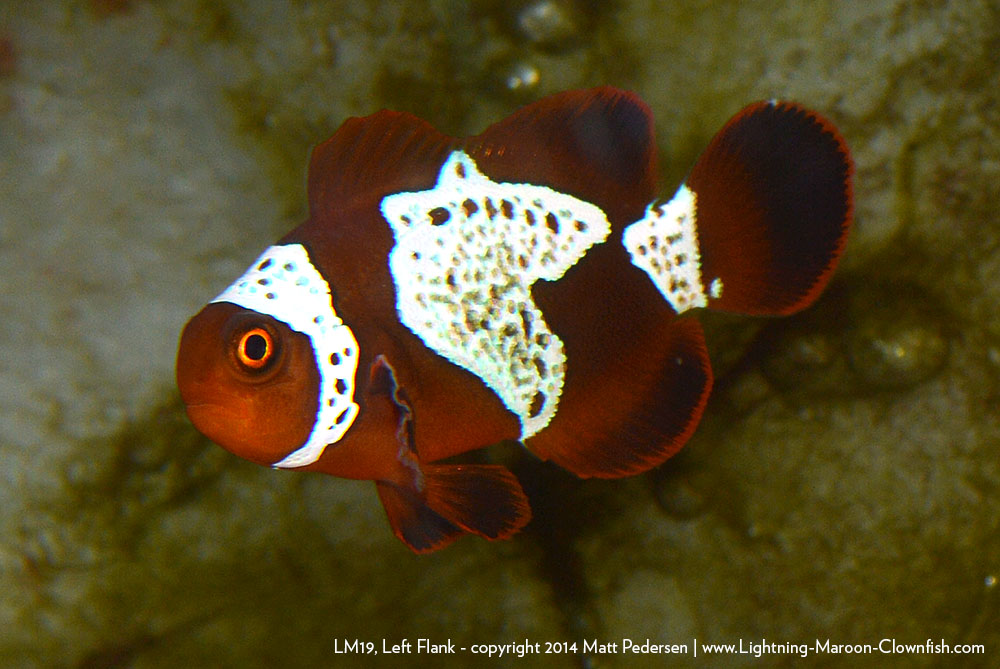
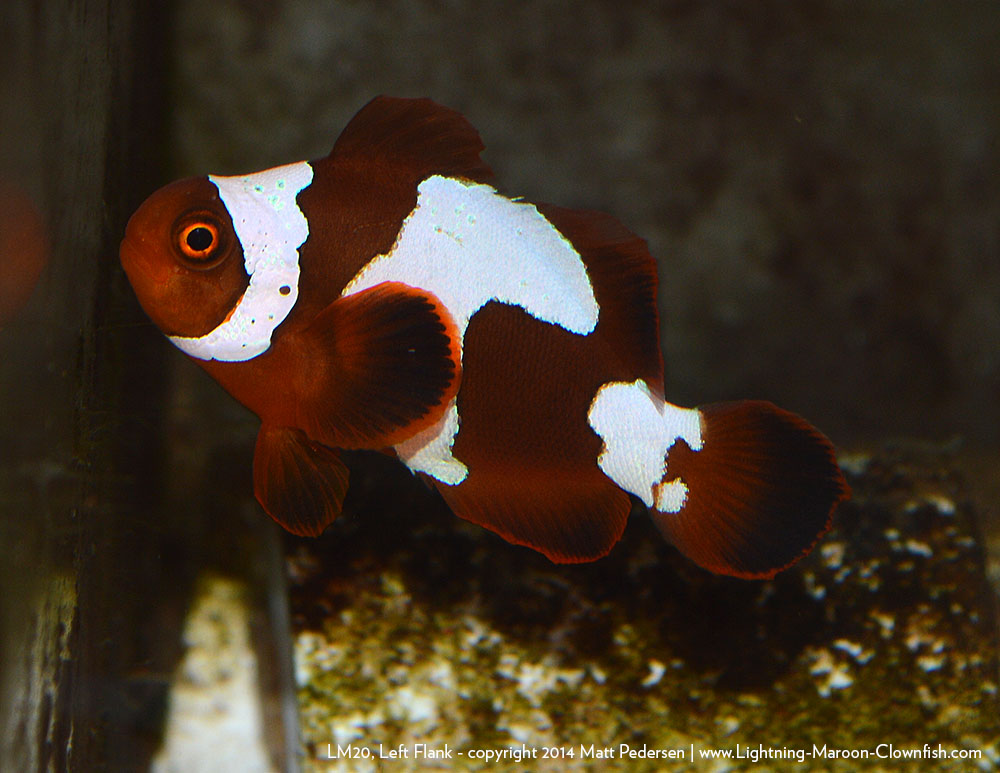
Enjoy!
I’m a man of my word; Mike reared a good batch with Spawn #27, and tonight, new photos of the ORA Gold Nugget Maroon Clownfish in Rhinelander (LiveAquaria’s Diver’s Den) were posted. The fish looked good, and being on sale from $499.99 to only $349.99, it was time to honor my end of the bargain. So this fish….

…is now Mike Doty’s and should be here on Tuesday morning.
I can’t say how blessed I am to have a fellow fish breeder who lives four blocks away and is willing to come feed babies on short notice….Mike I am always in your debt! Now lets see what this throws when paired with a standard Gold Stripe Maroon! My prognostication – we get 100% Gold Flake types out of it…
I made a rare 8 PM trek down into the fishroom tonight (6/4/2014) and discovered the Lightning Maroon and her mate putting down Spawn #34. Based on how things are going, next Tuesday night should be the pull night.
My attempt to get a second night’s hatch out of Spawn #33 utterly failed. I did place the tile back with the parents come morning, and I went through the egg sanitizing protocol (with H2O2) for another 15 minute bath. I saw ONE larvae hatch out…a total dud. My plan for the next spawn will be to pull the tile and 20 gallons out of the broodstock tank (BIG water change); 10 gallons each will go into two BRTs, and then I’ll simply move the tile from the first night’s hatch into the 2nd BRT for the 2nd night, sticking with the egg sanitizing protocol (as it seems to be helping?)
Those larvae that are alive from Spawn #33 are doing reasonably well..they are plowing through rotifers at an alarming rate; I’m adding in new saltwater along with RO/DI Water daily, as well as small feedings of TDO A to supplement for what I think might be a rotifer shortage. Low doses of ChloramX and RotiGreen Omega continue to be pulsed in as well.
It is now a fact – big Lightning Maroon Clownfish hatches are happening in the morning. I went to bed sometime after 4:30 AM on June 1st, and a few hours later, around 8:30, the kids woke me up. So, I went down to look at the BRT – just a handful of larvae. I checked with a light, none on the bottom…just a very weak hatch.
I greened up the tub with RotiGreen Omega and added 2 gallon’s worth of rotifers from a culture. I turned on the light, left the tile in place. Around 10:30 AM, I went down again and I now had hundreds of larvae in the BRT.
I pulled the tile and gave it back to the parents…can’t remember if that was an idea raised here, or on Facebook, but it seemed like a good way to go. I have yet to go back down tonight, but I’ll presumably set up yet another new tank for a hatch tonight and see if we get two solid night’s worth of larvae off this batch. Things could get interesting.
It’s the night of 5/31 going into 6/1/2014, and right before 2:00 AM (6/1) I pulled the tile for the sanitizing H2O2 (Hydrogen Peroxide) dip. While going through the 15 minute treatment at 4 ML per 0.5 gallons of broodstock water, I wiped out the BRT which was used for Spawn #32 and refilled it with 10 gallons of water from the broodstock tank. When I went to check on the eggs, with 25 seconds left, I discovered that about 30 larvae had already hatched.
I moved the tile into the BRT with good air flow using a coarse air stone and turned out the lights. I then spent a little time pipetting some of the larvae from the specimen cup, but I ultimately did not get them all and some had to go down the drain. I had to wonder – would these larvae be viable long term, or would their exposure to H2O2 burn them up and render them useless. So I wasn’t overly concerned, and I also didn’t want to add too much of that bath water into the BRT.
I’ll try to check on the hatch again in the next 30-45 minutes…I wonder if they’re going to go really fast, or if it’s in spurts (you may recall my concern over “morning” hatches…)
UPDATE – as of 4:20 AM, a last check of the night after just under 2 hours reveals no further large hatching occurred. I wonder if they’ll hatch come daylight? Hard to say…
Recent Comments